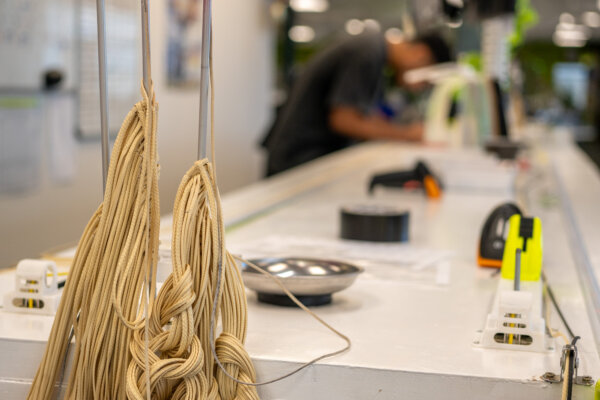We’ve published a Product Advisory Notice (2025) with the need-to-know on parachute line safety.
>>Read it here before you keep scrolling.
Skydiving is trusting physics, nylon, and your lines. Because that’s what every jump hangs on—literally. And when those lines start breaking down, you need more than a gear check. You need smarter line safety.
Why Smarter Line Safety Matters
Skydivers are pushing limits harder than ever. Bigger turns. Higher wingloadings. More jumps per weekend.
Progress is epic, but it puts more strain on our systems. While we were evolving as athletes, our lines weren’t keeping up.
We’ve seen in the skydiving industry, in cutaway videos we wish we hadn’t seen. Shit that makes your stomach turn because you know that could’ve been you. Or your mate.
The most dangerous failure point?
Lines that break not on opening, but close to the ground, after a line has already held tension. That’s the moment you have the least time to react.
This isn’t about fear. It’s about knowing your lines. Knowing not just how to check your lines, but what you’re looking at, and when to act.
Here’s What We Did:
- Surveyed jumpers to get the raw, unfiltered truth about line failures
- Ran stress tests in the JYRO Lab (and yep, we’re still testing—because science)
- Analysed the G-forces, the turns, the line tension, the chaos
- Watched line after line fail under controlled conditions
- Listened to athletes, riggers, and canopy geeks around the world
- It was a f%$& ton of testing and data analysis for a simple solution, making sure we know the shit we know.
What We Learned:
- Just because your lines look good doesn’t mean they are.
- A1 lines get the most wear and are a risk for landing.
- V300 on SLeia and Leia? It’s retired for a reason. They’re gone, not coming back.
- Jump numbers + exit weight = line health. Know your numbers. Own your risk.
Clean Lines Lie:
Some fail with zero visible wear. Yep. Ziltch. They looked clean. They broke anyway.
Why? Because not all damage is visible. Think: internal wear. Microscopic breakdown. Material wear that doesn’t show until it’s too late. Especially on high-performance wings and high-jump-count canopies where line tension hits differently.
And that’s where FailSmart comes in.
FailSmart: One Line Swap. Big Safety Win.
You know what’s worse than worn-out lines? Worn-out lines failing at the worst possible moment.
So we made a change. A smart one.
We beefed up the A1 lines on high-performance V400 and V300 linesets—just like we already do with brakes. Why? Because A1 takes a beating, especially during openings and landing.
What’s Changing:
- V550 is now standard for A1 on V400 linesets.
- V400 steps in for A1 on V300 linesets.
These stronger lines are now the default on:
- All new spare linesets using V400 or V300
- All new canopies with those line types
- LEIA FAILSMART LINES
- PETRA FAILSMART LINES
Will your lines last longer? No.
Will they fail smarter? Hell yes.
Here’s the bottom line: your lineset will still wear out after roughly the same number of jumps. But if something’s gonna snap, better it happens on deployment (C1) than mid-flight (A1). That’s the difference between “well, that was annoying” and “I’m lucky to be here.”
We still strongly recommend checking your lines regularly and changing them before they break!
And yup, we’re working on lifespan too—V550 is coming back for Leia—but right now, FailSmart is about parachute line failure prevention, not durability.
Get to Know Your Lines:
Visual checks are a starting point. Julien’s Know Your Lines formula gives you a simple, risk-cutting way to gauge line health. Learn it. Use it. Go Deeper with these tips:
- Tactile feel. Squishy where it should be crisp? You’ve got a problem.
- Tension irregularities. If something feels loose or asymmetrical, it probably is.
- Flight behavior. Odd flare? Uneven openings? These could be indicators.
Who Needs to Know? (Short Answer = You)
If you’re flying any of these wings:
Are you on a new canopy or lineset from JYRO? You’re already FailSmart.
Still on an older lineset? Time to inspect.
What You Need To Do Now
Know your lines! We’ve got some great resources to help you below.
Ask: “What lines am I on?”
If you don’t know—that’s your first step toward smarter line safety.
Watch: “How to Check Your Lines”
Go Deeper – Listen to our full R&D investigation by our Aerodynamics Engineer Julien Peelman: “They’re probably still good..maybe: JYROs no BS guide to safer parachute lines”
Our support team and sales peeps have decades of experience between them, so if you have questions, flick us a message.
The Bottom Line on Smarter Line Safety
FailSmart isn’t sexy. It’s just smart.
Because smarter line safety means fewer emergencies, fewer cutaways, and more time spent actually flying. And we’ll keep testing, refining, improving and basically being the nerdy sciencey innovators you know and love us for.
Until then?
Get to know your lines.
KEEP READING
21 Ways to Keep Your Canopy Looking Good!
5 Examples of Gear Hook Up Mistakes








